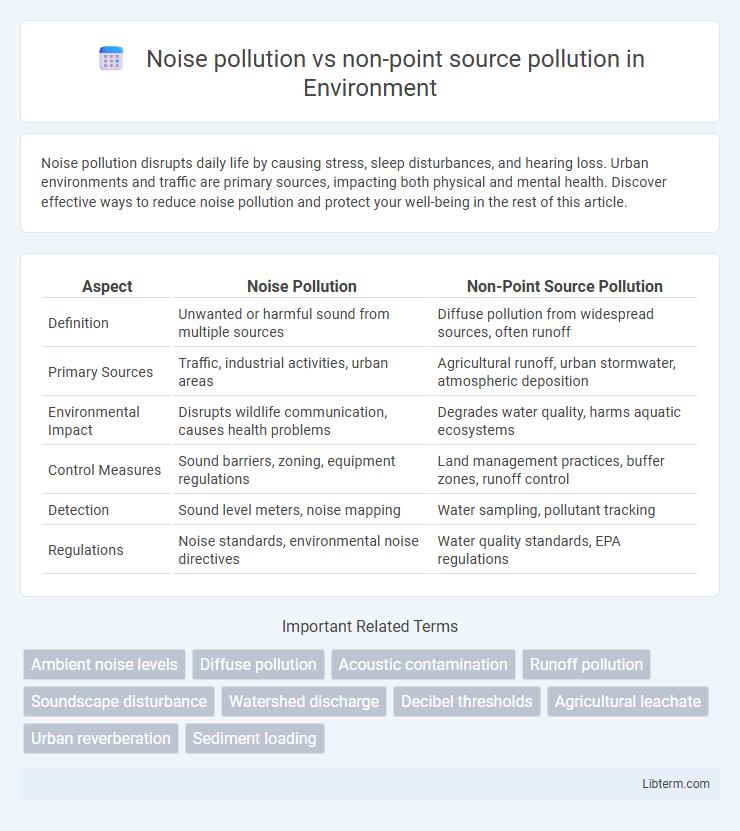Noise pollution disrupts daily life by causing stress, sleep disturbances, and hearing loss. Urban environments and traffic are primary sources, impacting both physical and mental health. Discover effective ways to reduce noise pollution and protect your well-being in the rest of this article.
Table of Comparison
| Aspect | Noise Pollution | Non-Point Source Pollution |
|---|---|---|
| Definition | Unwanted or harmful sound from multiple sources | Diffuse pollution from widespread sources, often runoff |
| Primary Sources | Traffic, industrial activities, urban areas | Agricultural runoff, urban stormwater, atmospheric deposition |
| Environmental Impact | Disrupts wildlife communication, causes health problems | Degrades water quality, harms aquatic ecosystems |
| Control Measures | Sound barriers, zoning, equipment regulations | Land management practices, buffer zones, runoff control |
| Detection | Sound level meters, noise mapping | Water sampling, pollutant tracking |
| Regulations | Noise standards, environmental noise directives | Water quality standards, EPA regulations |
Introduction to Noise Pollution and Non-Point Source Pollution
Noise pollution refers to unwanted or harmful sounds from sources like traffic, industrial activities, and urban development, adversely affecting human health and wildlife. Non-point source pollution is diffuse contamination originating from multiple sources such as agricultural runoff, urban stormwater, and atmospheric deposition, impacting water quality across broad regions. Both types of pollution pose significant environmental challenges by degrading ecosystems and reducing overall life quality.
Defining Noise Pollution: Sources and Characteristics
Noise pollution is defined as unwanted or harmful sound that disrupts the natural environment and human well-being, primarily originating from urban traffic, industrial activities, and construction sites. Characterized by high decibel levels and irregular patterns, noise pollution affects both auditory and non-auditory health, contributing to stress, hearing loss, and sleep disturbances. Unlike non-point source pollution, which stems from diffuse sources such as agricultural runoff and atmospheric deposition, noise pollution's sources are more identifiable and localized yet pervasive in metropolitan and industrial regions.
What is Non-Point Source Pollution? Key Features
Non-point source pollution originates from diffuse sources rather than a single, identifiable point, making it challenging to monitor and control. Key features include its widespread nature, typically involving runoff from agricultural fields, urban areas, and forestry activities carrying pollutants like fertilizers, pesticides, and sediments into water bodies. Unlike noise pollution, which involves unwanted sound causing environmental and health impacts, non-point source pollution primarily affects water quality and aquatic ecosystems through dispersed contamination.
Major Sources of Noise Pollution
Major sources of noise pollution include transportation systems such as road traffic, aircraft, and railways, which generate continuous and high-decibel noise affecting urban and suburban areas. Industrial activities, construction sites, and loud entertainment venues contribute significantly to ambient noise levels, often overlapping with the diffuse characteristics of non-point source pollution. Unlike non-point source pollution, which originates from multiple dispersed sources like agricultural runoff and urban stormwater, noise pollution primarily arises from identifiable, localized sources that impact human health and environmental quality.
Typical Sources of Non-Point Source Pollution
Non-point source pollution primarily originates from diffuse sources such as agricultural runoff, urban stormwater, and atmospheric deposition, which introduce contaminants like fertilizers, pesticides, and heavy metals into water bodies. In contrast, noise pollution stems from identifiable sources including traffic, industrial activities, and construction sites, contributing to environmental and health disturbances. The diffuse and varied nature of non-point source pollution makes it challenging to monitor and control compared to the relatively direct impact zones of noise pollution.
Environmental and Health Impacts: Noise vs. Non-Point Source Pollution
Noise pollution causes stress, hearing loss, sleep disturbances, and cardiovascular problems in humans, while disrupting wildlife communication and behavior. Non-point source pollution, originating from diffuse sources like agricultural runoff, leads to water contamination, eutrophication, and habitat degradation, severely impacting aquatic ecosystems and human health through polluted drinking water. Both forms of pollution pose significant environmental and health risks requiring targeted mitigation strategies to protect community well-being and biodiversity.
Monitoring and Measuring Pollution: Techniques and Challenges
Monitoring noise pollution involves using sound level meters and frequency analyzers to capture decibel levels and identify noise sources, with challenges including variable sound intensity and detecting intermittent noises. Non-point source pollution monitoring requires water sampling, remote sensing, and geographic information systems (GIS) to assess pollutant diffusion across large, diffuse areas, complicated by spatial variability and temporal fluctuations. Both pollution types demand advanced sensor technologies and data integration methods to accurately quantify impacts and guide mitigation efforts.
Regulatory Approaches: Noise Pollution vs Non-Point Source Pollution
Regulatory approaches to noise pollution primarily involve local ordinances, zoning laws, and specific noise limits set by agencies like the Environmental Protection Agency (EPA) and Occupational Safety and Health Administration (OSHA), focusing on controlling sound levels in residential and industrial areas. In contrast, non-point source pollution, often from diffuse sources like agricultural runoff, is regulated through best management practices (BMPs), state-level watershed management programs, and federal initiatives such as the Clean Water Act's Section 319 non-point source program. Enforcement for noise pollution relies on direct noise measurement and complaint-driven actions, while non-point source pollution regulation emphasizes voluntary compliance, education, incentives, and monitoring water quality trends.
Mitigation Strategies for Both Pollution Types
Mitigation strategies for noise pollution include implementing sound barriers, enforcing noise regulations, and promoting the use of quieter machinery and transportation options. Non-point source pollution can be reduced through best management practices such as adopting agricultural runoff controls, enhancing stormwater management systems, and restoring wetlands to filter pollutants. Both require community engagement and continuous monitoring to ensure effective reduction and long-term environmental health.
Future Trends and Solutions for Pollution Management
Emerging technologies such as AI-driven monitoring systems and IoT sensors are transforming noise pollution management by enabling real-time data analysis and targeted mitigation strategies. Advances in green infrastructure and sustainable urban planning are critical for addressing non-point source pollution by reducing runoff and enhancing natural filtration processes. Future pollution management relies on integrated approaches combining policy innovation, community engagement, and cutting-edge environmental engineering to effectively control both noise and non-point source pollution.
Noise pollution Infographic

 libterm.com
libterm.com